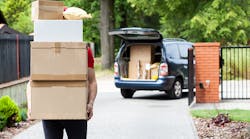It’s way too soon to declare that the truck driver shortage problem has been solved, but Amazon appears to have come up with a solution rather elegant in its simplicity but staggering in its implications: Anybody who wants to can be a delivery person. Just BYOV (bring your own vehicle).
That’s the basic premise behind the Amazon Flex program, where the company pays independent drivers (similar to Uber drivers, except they’re carrying packages, not people) to use their own cars to pick up packages at local warehouses and deliver them to customers’ houses. Drivers can make up to $25 per hour, but Amazon expects the drivers to cover their own expenses (e.g., fuel, insurance, maintenance). And $25 appears to be on the high side, with most Flex drivers making closer to $18 an hour, which after expenses can amount to considerably less than that. Still, the hourly rate for Flex drivers is higher than that for Uber drivers, in some cities at least, and there aren’t any nasty passengers in the back seat.
The grumbles about the Flex program—and with a program of this size and scope, you can expect there to be many grumbles—tend to center on how little managerial support Amazon offers to its drivers. A recent article in The Atlantic by Alana Semuels profiles the daily life of a Flex driver in San Francisco, who found that the downtown area has almost no provision—or parking spots—for Flex drivers, who face steep fines if ticketed in a no-parking zone. Not only doesn’t Amazon offer its drivers any guidance on where to park in busy cities, but it doesn’t pick up the cost of the ticket, either.
Also, according to Semuels, “Flex workers get no health insurance or pension, and are not guaranteed a certain number of hours or shifts a week. They are not covered by basic labor protections like minimum wage and overtime pay, and they don’t get unemployment benefits if they suddenly can’t work anymore.”
Be that as it may, the Flex program is just Amazon getting warmed up. The online giant’s latest foray into logistics is called Delivery Service Partners, which basically is a funding operation that aims to help individuals launch and run their own logistics companies to deliver Amazon packages. The company claims that owners can earn as much as $300,000 in annual profit (which, presumably, means after taxes and expenses) operating a fleet of up to 40 delivery vehicles. If the idea catches on, Amazon expects to see hundreds of small business owners employing tens of thousands of delivery drivers nationwide. And to get the idea up and running, Amazon has pledged $1 million to fund startup costs ($10,000 in reimbursement costs per person) for qualified military veterans who want to start their own delivery businesses.
“Customer demand is higher than ever and we have a need to build more capacity,” explains Dave Clark, Amazon’s senior vice president of worldwide operations. “As we evaluated how to support our growth, we went back to our roots to share the opportunity with small-and-medium-sized businesses. We are going to empower new, small businesses to form in order to take advantage of the growing opportunity in e-commerce package delivery.”
As you’ll recall, Amazon, learned its lesson the hard way about what happens when you disappoint a lot of customers, back in December 2013 when traditional carriers like UPS, FedEx and the USPS were unable to meet the tight delivery windows that Amazon was promising. No company wants to have to explain why Junior’s hoped-for presents didn’t make it under the tree on Christmas morning, and Amazon was bound and determined it wouldn’t happen again. So in the fine tradition of disintermediation, the company has figured out how to drastically reduce its reliance on traditional carriers by paying people—not Amazon employees earning wages and benefits, but ordinary Joes and Janes willing to operate as independent contractors—to deliver the goods.
Ever since that holiday debacle of 2013, the company has been relentless in its pursuit of new delivery paradigms that sound a bit kooky at first, maybe, but have quickly caught on, such as Amazon Key, that allows drivers to actually enter your home or unlock your car’s trunk to drop off your packages; AmazonFresh, which enables same-day delivery of fresh food; Alexa and Echo, which were once thought of as merely cynical ploys by Amazon to make it easier for people to order stuff online but which are now truly virtual assistants for the entire home. Amazon also reportedly has a patent for a delivery robot that not only can deliver goods into your house but won’t complain about not getting minimum-wage or healthcare benefits. Now if Amazon could figure out a way to get the robot to make purchases for itself, that would truly be the ultimate in disintermediation.




